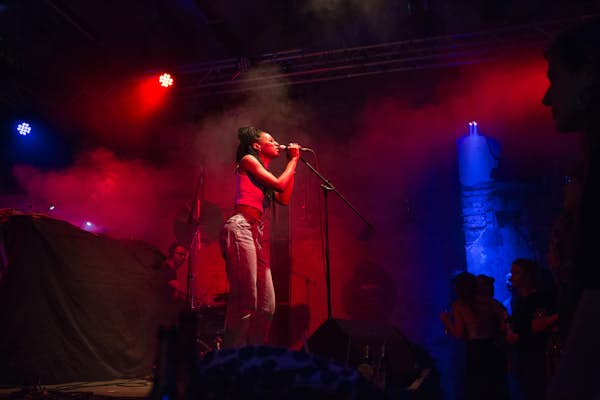Hope for the dance floor? How Berlin is ushering in a new era of club culture
The challenges facing Berlin’s legendary club scene have never been greater. And the scene is more resilient than ever.

From daytime raves to a club etiquette driven by sex positivity, anonymity and respect, Berlin’s nightlife scene is truly one of a kind.
Indeed, the German capital is a global destination for electronic music, with more than 1600 artistic and cultural venues to discover in its concrete jungle, according to the leading clubbing platform Resident Advisor. Visitors from all over the world come to experience a unique club culture that's diverse, welcoming and vibrant. It's one of Berlin's biggest pulling powers.
Yet as a decade-long Berliner (as well as a DJ who plays at local clubs), I regret to report that things have changed of late. The scene may seem to be vibing like the Energizer Bunny – cool as ever behind dark sunglasses and thumping bass – yet in many ways it’s also losing juice. The effects of gentrification – namely, ever-rising rents due to property speculation – as well as the long tail of the pandemic have zapped much local creative power.
Already, some 100 nightlife venues in Berlin have fallen victim to these unwelcome trends. The German media has dubbed the phenomenon Clubsterben (club death), with Berlin’s nightlife association, Clubcommission, citing gentrification as a principal factor.
The stakes are high: Berlin’s fate as a hotspot for counterculture alternative lifestyles hangs in the balance.
Yet some hope remains on the dance floor, thanks to a few new moves on the scene. Since 2020, several disused historic buildings have been transformed into high-capacity performance venues, with two notable openings in 2023. With space to host hundreds, even thousands, of partiers and a focus on electronic music, these ventures aim to usher in a new era of club culture for Berlin – hopefully providing fresh eclecticism and joy to counter the Clubsterben curse.
Outdoor raves and pop-up parties remain mainstays of the Berlin party scene © Christian Ender / Getty ImagesTurning up the creative bass
Finding places in Berlin to throw parties is harder than ever – but that doesn’t mean nightlife aficionados have given up. Illegal raves in Spätis (convenience stores) and in parks and forests (a trend that largely emerged during the pandemic) are more prevalent than ever, though they’re limited to promotion by word of mouth and often thwarted by police and noise complaints.
Without more large-scale party spaces – and the budget to properly transform them and install the right sound systems – the scene will cease to draw in new acts and revelers, socially and economically hindering the city’s community of music artists from nurturing their craft and making a living. Yet Berlin is still packed with disused industrial buildings just waiting to also be turned into fellow shabby-chic venues emblematic of the city’s gritty character. It’s finding money to renovate and the will to issue permits that remains the perennial issue.
So Berlin’s creative community is cooperating more closely. At 3747 sq m (30,330 sq ft) and with a capacity of 700, new club Turbulence is the result of the efforts a group of local cultural foundations banding together. Situated in the canteen of the former Tegel Airport – an eccentric, bright-orange building that’s oh-so Berlin – the aptly named venue is taking off as a platform for underground culture, from multi-genre electronic music to visual and performance art. Turbulence embodies the scene’s new mantra of creating accessible, inclusive social spaces – and, since it shares the building with many tech start-ups, exemplifies a “work hard, play hard” attitude, too.
Another club, Zita, opened this year in a former fortress in Spandau. The Renaissance-era citadel was once an imperial war treasury and, more sinisterly, a Nazi chemical weapons lab – and is now playing host to electronic music parties, drawing up to 2000 people to its cavernous, arch-filled brick halls. So far, the event program caters more to more-commercial music – think house and techno – rather than the bread-and-butter sounds of Berlin’s electronic scene.
Zita will take over the Citadel Spandau building in Berlin © Shutterstock / Drone-Photography“Recycling” abandoned spaces
In Treptower Park – against the Spree River’s banks and past the Soviet War Memorial and military cemetery – Zenner, open since 2021, offers a range of indoor and outdoor spaces for modern-day performances. In a palatial villa, a beer garden and a concert hall, it’s already hosted fantastic parties, with both big-name and obscure international acts taking the stage to offer live ambient music, all-vinyl Italo-disco DJ sets and more. Similarly, brewery–turned–techno club Revier Südost and its next-door venue Baergarten are homes for diverse electronic music – but also community and family events like bingo and poetry slams.
Clearly, such new clubs have taken inspiration from iconic strongholds in other architecturally transformed buildings, such as Sisyphos (in a former dog biscuit factory), KaterBlau (once a soap factory) and Renate (a repurposed multi-level apartment building – it shares the same ownership as Zenner). Yet they’ll have to put extra work into attracting crowds, being all mostly outside the inner-city ring (Zenner is the exception).
From a Nazi-era bunker turned art museum to an airfield that’s now an urban park, Berlin is a master at reinventing abandoned spaces, often with troubled pasts, for new moments and missions. Indeed, it’s urban rejuvenation that made Berlin the world’s electronic-music capital back in the ’90s, when clubs like Tresor and Berghain (then called Ostgut) emerged in bygone GDR buildings. They remain icons to this day.
While techno incited freedom and unity after the oppression and separation of the Berlin Wall era, its success has also been cannibalizing. Now wildly successful (generating €1.48 billion locally each year, according to Clubcommission statistics), the nightlife scene has contributed to Berlin’s cool factor – and ushered in a boom of moneyed expats. Critics decry that “business techno” – clubs that put profits ahead of a commitment to the artistic value of emancipation for marginalized people – contributes to ever-rising club-ticket prices and stagnant rates for artists.
Protests against a proposed freeway expansion have drawn a cross section of Berlin partygoers © Fabian Sommer / picture alliance via Getty ImagesSteamrolled by the A100?
While the beat of Berlin nightlife skips on, the scene is potentially facing its biggest challenge yet. A proposed €1.5 billion extension of the A100 Autobahn highway threatens to leave 20 different clubs and cultural sites demolished, including cult favorites like Renate and //:about blank, both located in former GDR historic buildings turned party hotspots.
Ravers and climate activists have joined forces to protest the highway, though the outcome remains unclear. Still, understanding the importance of Berlin club culture, as well as historic architecture, to the city’s unique spirit and landscape, some politicians seem to be listening. Legislation recently introduced in the German Parliament proposes new protection measures for cultural venues, including clubs, and could protect venues in inner-city areas while helping to address sound and noise-proofing issues through new funding and support.
Take it from me: Berlin’s nightlife scene is still vibrant: with denizens in over-the-top leather and latex outfits still packing snaking party queues, some visitors may never even know the precarity of the current moment. Yet in my humble opinion, the loss of historical buildings is just one detail in a greater picture of Berlin's fading charms. Once you lose social spaces for the counterculture, you’ll lose the vibrant, diverse folks who bring them to life.
They are the city’s true foundation.



















